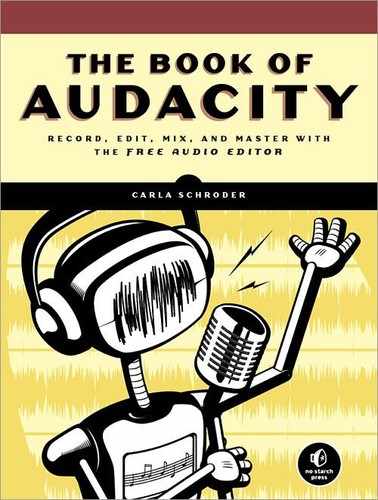Thanks to the Internet, everyone who is anyone is making podcasts., Now anyone with a little bit of recording gear and an Internet connection can create an audio broadcast to share with the world. You can tell stories, report news, and share how-tos. Your podcast can be just you talking, you interviewing another person, you and a cohost, or you and a gaggle of cohosts and guests. You can add a music track or special effects. Making podcasts with Audacity is easy and fun.
Once you have created your masterpiece, you need a website to host it and make it available to your eager audience. The Internet is full of free and inexpensive podcast hosts. If you have enough bandwidth and want to be your own server admin, you can be your own host thanks to the multitudes of free and open source streaming server software.
The term podcast used to refer to downloadable MP3-encoded recordings for iPods. Apple made a brief, ferocious attempt to own the word pod and sicced lawyers on a number of small businesses who dared to use the word, such as TightPod (laptop-protecting covers), Profit Pod (data collector for vending machines), Spodradio (a German online broadcaster), and Podcast Ready (another online broadcaster). Fortunately, it seems that the attack lawyers have moved on to something else, and it is safe to say “pod” again. So, that is what we are going to do: pea pod, pod of whales, pod people. Open the pod bay door, Hal.
Audacity is a dandy tool for making podcasts. You can use a digital recorder and then dump the recording into Audacity for editing, or you can record directly into a computer. A USB microphone or headset connected to a netbook makes a great lightweight portable recording studio. Or, you may indulge in using an entire studio full of fancy expensive gear; it’s entirely up to you.
Up until now in this book I’ve been nattering on about high-quality audio and not using lossy, compressed audio file formats. With podcasts we’re going the other way: smaller file sizes and lossy, compressed formats. You still want to start with creating a high-quality master, but it’s not necessary to treat your podcast the same way as an ultimate audiophile music recording, because it is going to be trimmed down for Internet streaming and fast downloads.
You may want to review Chapter 1 and Chapter 2 first to learn the fundamentals of using Audacity and how to set up your recording gear.
Making a simple podcast takes just a few steps:
Make your recording.
Edit it in Audacity: trim, repair, normalize—the usual cleanups and fixes.
Export to a playable compressed format such as Ogg Vorbis or MP3.
Upload to a site where your fans can download and enjoy your podcast.
Let’s take a look at the finer points of making a good podcast.
Note
Audio terminology is a bit confused when it comes to defining track. Track can be a single mono track, a stereo track, and even a sound track. In Audacity, it is helpful to think of a track as any single editable unit, which is any mono track or stereo track. Any edits that you make, such as deletions, additions, special effects, and so on, will be applied equally to the left and right channels in an Audacity stereo track.

